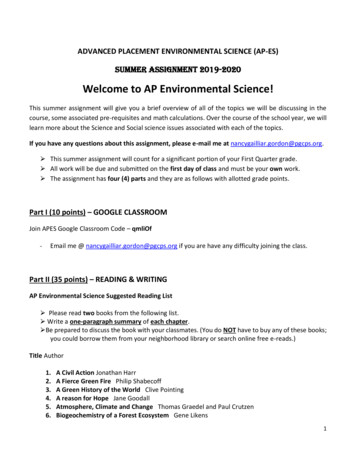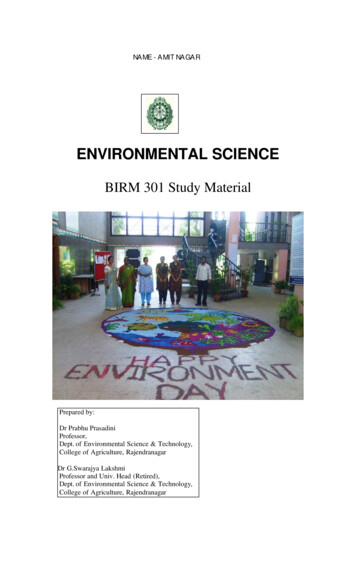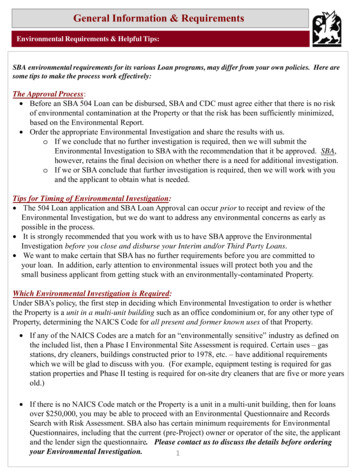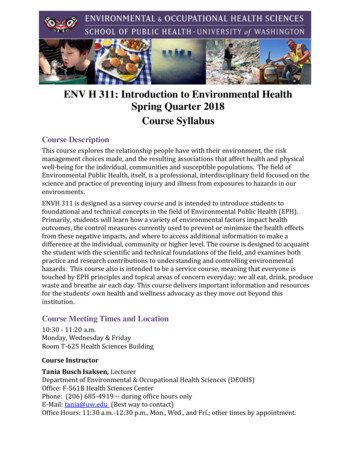
Transcription
ADVANCED PLACEMENT ENVIRONMENTAL SCIENCE (AP-ES)SUMMER ASSIGNMENT 2019-2020Welcome to AP Environmental Science!This summer assignment will give you a brief overview of all of the topics we will be discussing in thecourse, some associated pre-requisites and math calculations. Over the course of the school year, we willlearn more about the Science and Social science issues associated with each of the topics.If you have any questions about this assignment, please e-mail me at nancygailliar.gordon@pgcps.org. This summer assignment will count for a significant portion of your First Quarter grade. All work will be due and submitted on the first day of class and must be your own work. The assignment has four (4) parts and they are as follows with allotted grade points.Part I (10 points) – GOOGLE CLASSROOMJoin APES Google Classroom Code – qmliOf-Email me @ nancygailliar.gordon@pgcps.org if you are have any difficulty joining the class.Part II (35 points) – READING & WRITINGAP Environmental Science Suggested Reading List Please read two books from the following list. Write a one-paragraph summary of each chapter. Be prepared to discuss the book with your classmates. (You do NOT have to buy any of these books;you could borrow them from your neighborhood library or search online free e-reads.)Title Author1.2.3.4.5.6.A Civil Action Jonathan HarrA Fierce Green Fire Philip ShabecoffA Green History of the World Clive PointingA reason for Hope Jane GoodallAtmosphere, Climate and Change Thomas Graedel and Paul CrutzenBiogeochemistry of a Forest Ecosystem Gene Likens1
7. Cadillac Desert Marc Reisner8. Changes in the Land William Cronon9. Climate Change: The IPCC Scientific Assessment J.T. Houghton et al.10. Deep Ecology Bill Devall11. Degrees of Disaster: Prince William Sound Jeff Wheelwright12. Desert Solitaire Edward Abbey13. Digging Dinosaurs John Horner14. Earth in Mind David Orr15. Earth in the Balance Al Gore16. Earth Under Siege Richard P. Turco17. Ecology and the Politics of Scarcity William Ophuls18. Ecology, Economics, Ethics: The Broken Circle Bonnann and Kellert19. Eco-warriors Rick Scarce20. Encounters with the Archdruid John McPhee21. Endurance: Shackelton’s legendary Antarctic Expedition Caroline Alexander22. Energy: From Nature to Man William C. Reynolds23. Extinction: Bad Genes or Bad Luck David Raup24. Field Guide to Nature Observation and Tracking Tom Brown25. Four Corners Kenneth Brown26. Gorillas in the Mist Dianne Fossey27. Green Delusions Martin Lewis28. Guns, Germs and Steel Jared Diamond29. How Many People Can the Earth Support? Joel E. Cohen30. How Much Should a Person Consume? Environmentalism in India and the United States Ramachandra Guha31. In the Shadow of Man Jane Goodall32. Into the Wild Jon Krakauer33. Into Thin Air: Personal Account of the Mt Everest Disaster Jon Krakauer34. Isaac's Storm Eric Larson35. Ishmael Daniel Quinn36. Jonathan Livingston Seagull Richard Bach37. Last Refuge: Environmental Showdown in the American West Jim Robbins38. Life in the Balance: Humanity and the Biodiversity Crisis Niles Eldridge39. Living Downstream: Cancer and the Environment Sandra Steingraber40. No Turning Back Richard Ellis41. Ocean’s End Colin Woodward42. Of Wolves and Men Barry Lopez43. On Human Nature E.O. Wilson44. Our Ecological Footprint Wackernagel and Rees45. Out of Gas: The End of the Age of Oil David Goodstein46. Pilgrim at Tinker Creek Ann Dillard47. Prisoner's Dilemma William Poundstone48. Red Sky at Morning James Gustave Speth49. Replenish the Earth Lewis Regebstein50. Sand County Almanac Aldo Leopold51. Silent Spring Rachel Carson2
52. Silent Snow Marla Cone53. Sociobiology E.O. Wilson54. Strange Encounters Daniel Botkin55. Surely You're Joking Mr. Feynmann? Richard Feynmann56. Tales of the Shaman's Apprentice Mark Plotkins57. The Burning Season Andrew Revkin58. The Cold and the Dark: The World After Nuclear War Carl Sagan, Paul Ehrlich et al59. The Coming Plague Laurie Garrett60. The Condor’s Shadow David S. Wilcove61. The Control of Nature John McPhee62. The Cowboy Way David Mc Cumber63. The Dinosaur Heresies Robert Bakker64. The Diversity of Life E.O. Wilson65. The End of Food Paul Roberts66. The End of Nature Bill McKibben67. The Future of Life E.O. Wilson68. The Heat is On: Climate Crisis - Ross Gelbspan69. The Limits to Growth - 2nd Edition Donella Meadows70. The Monkey Wrench Gang Edward Abbey71. The Naturalist E.O. Wilson72. The Night of the Grizzlies Jack Olsen73. The Perfect Storm Sebastian Junger74. The Population Bomb Paul Ehrlich75. The Population Explosion Paul and Anne Ehrlich76. The Sand Dollar and the Slide Rule Delta Willis77. The Sixth Extinction Richard Leakey78. The Solace of Open Spaces Gretel Ehrlich79. The Song of the Dodo David Quammen80. The Stork and the Plow Paul Ehrlich81. The Warning: The Accident at Three Mile Island Mike Gray and Ira Rosen82. Three Scientists and Their Gods Robert Wright83. Tinkering with Eden Kim Todd84. Tracking the Vanishing Frogs Kathryn Phillips85. Walden Pond Henry Thoreau86. Why People Believe Weird Things Michael Shermer87. Where Mountains are Nameless: ANWR Jonathon Waterman88. Wolves of Isle Royale Rolk Peterson3
Part III (35 points) - Math Review and PreparationIn AP Environmental Science class, you will hear the two words most dreaded by high school students NO CALCULATORS! That is correct! You cannot use a calculator on the AP Environmental Science exam.The tests you will take are designed to prepare you for the AP College Board Exam. You will not be able touse calculators on regular tests all year either. Most calculations on the tests and exams require easycalculations and result in whole numbers or only a few decimal places. The challenge is in setting up theproblems correctly and knowing enough basic math to solve the problems. With practice, you will be amath expert by the time you take the AP Environmental Science ExamSo, put your calculator away and refresh your math skills!You will be tested on the math skills in this packet the second week of school!Contents-DecimalsAveragesPercentages and Percent changeMetric UnitsScientific NotationDimensional AnalysisReminders1. Write out all your work, even if it requires a simple task.- This is required on the APES exam so it will be required on all your assignments, labs, quizzes, andtests as well.2. Include units in each step.- Your answers always need units and it is important to write them in every step.3. Check your work.4. Go back through each step to make sure you did not make any mistakes in your calculations.5. Check to determine if your answer makes sense. For example, a person probably will not eat 13 million pounds of meat in a year. If you get an answer that seems unlikely, it probably is. Go back and review your work!4
Directions1.2.3.4.Read each section below for review.Look over the examples and use them for help on the practice problems.When you get to the practice problems, write out all your work and be sure to include units on each step.Check your work.DecimalsPart I: The BasicsDecimals show fractional numbers. The first number behind the decimal is the tenths place, the next is thehundredths place, and the next is the thousandths place. Places beyond that should be in scientific notation. (SeeScientific Notation section)Create a Place Value Chart to illustrate the places from ones to millions and tenths to millionths.Part II: Adding or Subtracting DecimalsTo add or subtract decimals, make sure you line up the decimals and then fill in any extra spots with zeros. Add orsubtract just like usual. Be sure to put a decimal in the answer aligned with the ones in the problem.Part III: Multiplying DecimalsLine up the numbers just as you would if there were no decimals. DO NOT line up the decimals. Write the decimalsin the numbers but then ignore them while you are solving the multiplication problem just as you would if therewere no decimals at all. After you have your answer, count all the numbers behind the decimal point(s). Count thesame number of places over in your answer and write in the decimal.5
Part IV: Dividing DecimalsScenario One: If the divisor (the number after the / or before the) does not have a decimal, set up theproblems just like a regular division problem. Solve the problem just like a regular division problem. When youhave your answer, put a decimal in the same place as the decimal in the dividend (the number before the / or underthe).Scenario Two: If the divisor does have a decimal, make it a whole number before you start. Move the decimal tothe end of the number, and then move the decimal in the dividend the same number of places.Then solve the problem just like a regular division problem. Put the decimal above the decimal in the dividend.(See Scenario 1 problem).Practice: Remember to show all your work, include units if given, and NO CALCULATORS! All work and answers goon your answer sheet.1.2.3.4.5.6.7.8.1.678 2.456 344.598 276.9 1229.078 .0567 45.937 – 13.43 199.007 – 124.553 90.3 – 32.679 28.4 x 9.78 324.45 x 98.4 6
9.10.11.12.1256.93 x 12.38 64.5 / 5 114.54 / 34.5 3300.584 / 34.67 AveragesTo find an average, add all the quantities given and divide the total by the number of quantities.Example: Find the average of 10, 20, 35, 45, and 105.Step 1: Add all the quantities. 10 20 35 45 105 215Step 2: Divide the total by the number of given quantities. 215/5 43Practice: Remember to show all your work, include units if given. NO CALCULATORS! Show your work and put your answers on your answer sheet.13. Find the average of the following numbers: 11, 12, 13, 14, 15, 23, and 2914. Find the average of the following numbers: 124, 456, 788, and 34315. Find the average of the following numbers: 4.56, .0078, 23.45, and .9872PercentagesIntroduction:Percentages show fractions or decimals with a denominator of 100. Always move the decimal TWO places to theright go from a decimal to a percentage or TWO places to the left to go from a percent to a decimal.Examples: .85 85%.008 .8%Part I: Finding the Percent of a Given NumberTo find the percent of a given number, change the percent to a decimal and MULTIPLY.Example: 30% of 400Step 1: 30% .30Step 2: 400x .3012000Step 3: Count the digits behind the decimal in the problem and add decimal to the answer.12000 120.00 1207
Part II: Finding the Percentage of a NumberTo find what percentage one number is of another, divide the first number by the second, then convert the decimalanswer to a percentage.Example: What percentage is 12 of 25?Step 1: 12/25 .48Step 2: .48 48% (12 is 48% of 25)Part III: Finding Percentage Change & Increase or DecreaseTo find percent change: (New - old)/ old x 100Example: The iPhone has decreased from 650 to 515. What is the percent change in the price?Step 1: 515 - 650 - 135 We use absolute value in this class. You can ignore the negative.Step 2: 135 / 650 .208Step 3: .208 X 100 20.1%To find a percentage increase or decrease, first find the percent change, then add or subtract the change to theoriginal number.Example: Kindles have dropped in price 18% from 139. What is the new price of a Kindle?Step 1: 139 x .18 25Step 2: 139 - 25 114Part IV: Finding a Total ValueTo find a total value, given a percentage of the value, DIVIDE the given number by the given percentage.Example: If taxes on a new car are 8% and the taxes add up to 1600, how much is the new car?Step 1: 8% .08Step 2: 1600 / .08 160,000 / 8 20,000(Remember when the divisor has a decimal, move it to the end to make it a whole number and move thedecimal in the dividend the same number of places. .08 becomes 8, 1600 becomes 160000.)Practice: Remember to show all your work, include units if given. NO CALCULATORS! All work and answers go on your answer sheet.16. What is 45% of 900?17. Thirteen percent of a 12,000-acre forest is being logged. How many acres will be logged?18. A water heater tank holds 280 gallons. Two percent of the water is lost as steam. How many usable gallonsremain?19. What percentage is 25 of 162.5?20. What percentage of 2800 is thirty-five (35)?21. 14,000 acres of a 40,000-acre forest burned in a forest fire. What percentage of the forest was damaged?22. You have driven the first 150 miles of a 2000-mile trip. What percentage of the trip have you traveled?8
23. Home prices have dropped 5% in the past three years. An average home in Indianapolis three years agowas 130,000. What is the average home price now?24. In 1998, approximately, 30 million mobile devices sold in the United States. The number sold increased to180 million devices in 2007. Calculate the percent increase of mobile device sales from 1998 to 2007.25. 235 acres, or 15%, of a forest is being logged. How large is the forest?26. A teenager consumes 20% of her calories each day in the form of protein. If she is getting 700 calories aday from protein, how many calories is she consuming per day?27. In a small oak tree, the biomass of insects makes up 3000 kilograms. This is 4% of the total biomass of thetree. What is the total biomass of the tree?Metric UnitsKilo-, centi-, and milli- are the most frequently used prefixes of the metric system. You need to be able to go fromone to another without a calculator. You can remember the order of the prefixes by using the following sentence:King Henry Died By Drinking Chocolate Milk. Since the multiples and divisions of the base units are all factors often, you just need to move the decimal to convert from one to another.Example: 55 centimeters ? KilometersStep 1: Figure out how many places to move the decimal. King Henry Died By Drinking – that’s sixPlaces. (Count the one you are going to, but not the one you are on.)Step 2: Move the decimal five places to the left since you are going from smaller to larger.55 centimeters .00055 kilometersExample: 19.5 kilograms ? MilligramsStep 1: Figure out how many places to move the decimal. Henry Died By Drinking Chocolate Milk –That is six places. (Remember to count the one you are going to, but not the one you are on.)Step 2: Move the decimal six places to the right since you are going from larger to smaller.In this case, you need to add zeros.19.5 kilograms 19,500,000 milligrams9
Practice: Remember to show all your work, include units if given, and NO CALCULATORS!All work and answers go on your answer sheet.28.29.30.31.32.33.1200 kilograms ? milligrams14000 millimeters ? meters670 hectometers ? centimeters6544 liters ? milliliters.078 kilometers ? meters17 grams ? kilogramsScientific NotationIntroduction: Scientific notation is a shorthand way to express large or tiny numbers. Since you will need to do calculations throughout the year WITHOUT A CALCULATOR, we will consideranything over 1000 to be a large number. Writing these numbers in scientific notation will help you do yourcalculations much quicker and easier and will help prevent mistakes in conversions from one unit toanother. Scientific notation is based on a decimal system or units of 10, as is the metric system.A large number written in scientific notation looks like this:1.23 x 1011- The number before the x (1.23) is called the coefficient.- The coefficient must be greater than 1 and less than 10.- The number after the x is the base number and is always 10.- The number in superscript (11) is the exponent.Part I: Writing Numbers in Scientific NotationWrite a large number in scientific notation; put a decimal after the first digit. Count the number of digits after thedecimal you just wrote in. This will be the exponent. Drop any zeros so that the coefficient contains as few digitsas possible.Example: 123,000,000,000Step 1: Place a decimal after the first digit. 1.23000000000Step 2: Count the digits after the decimal there are 11.Step 3: Drop the zeros and write in the exponent. 1.23 x 1011Writing tiny numbers in scientific notation is similar. The only difference is the decimal is moved to the left and the exponent is a negative. A tiny number written in scientific notation looks like this:4.26 x 10-810
- To write a tiny number in scientific notation, move the decimal after the first digit that is not azero.- Count the number of digits before the decimal you just wrote.- This will be the exponent as a negative. Drop any zeros before or after the decimal.Example: .0000000426Step 1: 00000004.26Step 2: Count the digits before the decimal there are eight.Step 3: Drop the zeros and write in the exponent as a negative. 4.26 x 10-8Part II: Adding and Subtracting Numbers in Scientific Notation To add or subtract two numbers with exponents, the exponents must be the same. You can do this by moving the decimal one way or another to get the exponents the same. Once the exponents are the same, add (if it is an addition problem) or subtract (if it is a subtraction problem)the coefficients just as you would any regular addition problem (review the previous section about decimalsif you need to). The exponent will stay the same. Make sure your answer has only one digit before the decimal – you may need to change the exponent ofthe answer.Example: 1.35 x 106 3.72 x 105 ?Step 1: Make sure both exponents are the same. It is usually easier to go with the larger exponent.You do not have to change the exponent in your answer, so let us make both exponents 6 for thisproblem.3.72 x 105 .372 x 106Step 2: Add the coefficients just as you would regular decimals. Remember to line up the decimals.1.35 .3721.722Step 3: Write your answer including the exponent, which is the same as what you started with.1.722 x 106Part III: Multiplying and Dividing Numbers in Scientific NotationTo multiply exponents, multiply the coefficients just as you would regular decimals. Then add the exponents toeach other. The exponents DO NOT have to be the same.Example: 1.35 x 106 X 3.72 x 105 ?Step 1: Multiply the coefficients.1.35x 3.7227011
94504050050220 5.022Step 2: Add the exponents.5 6 11Step 3: Write your final answer.5.022 x 1011To divide exponents, divide the coefficients just as you would regular decimals, and then subtract the exponents.In some cases, you may end up with a negative exponent.Example: 5.635 x 103 / 2.45 x 106 ?Step 1: Divide the coefficients.5.635 / 3.45 2.3Step 2: Subtract the exponents.3 – 6 -3Step 3: Write your final answer.2.3 x 10-3Practice: Remember to show all your work, include units if given. NO CALCULATORS! All work and answers go on your answer sheet.Write the following numbers in scientific notation:34. 145,000,000,00035. 13 million36. .00034837. 135 trillion38. 24 thousandComplete the following calculations:39. 3 x 103 4 x 10340. 4.67 x 104 323 x 10341. 7.89 x 10-6 2.35 x 10-842. 9.85 x 104 – 6.35 x 10443. 2.9 x 1011 – 3.7 x 101312
44.45.46.47.48.49.50.51.52.53.54.1.278 x 10-13 – 1.021 x 10-10three hundred thousand plus forty-seven thousand13 million minus 11 thousand1.32 x 108 X 2.34 x 1043.78 x 103 X 2.9 x 102three million times eighteen thousandone thousandth of seven thousandeight ten-thousandths of thirty-five million3.45 x 109 / 2.6 x 1031.98 x 10-4 / 1.72 x 10-6twelve thousand divided by four thousandDimensional AnalysisIntroductionDimensional analysis is a way to convert a quantity given in one unit to an equal quantity of another unit by liningup all the known values and multiplying. It is called factor labeling. The best way to start a factor-labeling problem is by using what you already know. In some cases, you may use more steps to find the same answer, but it does not matter. Use what you know, even if the problem goes all the way across the page!In a dimensional analysis problem, start with your given value and unit and then work toward your desired unit bywriting equal values side by side. Remember you want to cancel each of the intermediate units. To cancel a uniton the top part of the problem, you have to get the unit on the bottom. Likewise, to cancel a unit that appears onthe bottom part of the problem, you have to write it in on the top.Once you have the problem written out, multiply across the top and bottom and then divide the top by the bottom.Example:3 years ? SecondsStep 1: Start with the value and unit you are given. There may or may not be a number on the bottom.3 yearsStep 2: Start writing in all the values you know, making sure you can cancel top and bottom. Since youhave years on top right now, you need to put years on the bottom in the next segment. Keepgoing, canceling units as you go, until you end up with the unit you want (in this case seconds)on the top.3 years365 days1 year24 hours1 day60 minutes1 hour60 seconds1 minuteStep 3: Multiply all the values across the top. Write in scientific notation if it’s a large number. Writeunits on your answer.13
3 x 365 x 24 x 60 x 60 9.46 x 107 secondsStep 4: Multiply all the values across the bottom. Write in scientific notation if it’s a large number.Write units on your answer if there are any. In this case everything was cancelled so there areno units.1x1x1x1 1Step 5: Divide the top number by the bottom number. Remember to include units.9.46 x 107 seconds / 1 9.46 x 107 secondsStep 6: Review your answer to see if it makes sense. 9.46 x 107 is a really big number. Does it make sense forthere to be a lot of seconds in three years? YES! If you had gotten a tiny number, then you would need to go backand check for mistakes.In lots of AP Environmental Science (AP-ES) problems, you will need to convert both the top and bottom unit. Do not panic! Just convert the top one first and then the bottom.Example:50 miles per hour ? Feet per secondStep 1: Start with the value and units you are given. In this case, there is a unit on top and on bottom.50 miles1 hourStep 2: Convert miles to feet first.50 miles1 hour5280 feet1 mileStep 3: Continue the problem by converting hours to seconds.50 miles1 hour5280 feet1 mile1 hour60 minutes1 minute60 secondsStep 4: Multiply across the top and bottom. Divide the top by the bottom. Be sure to include units oneach step. Use scientific notation for large numbers.50 x 5280 feet x 1 x 1 264000 feet1 x 1 x 60 x 60 seconds 3600 seconds264000 feet / 3600 seconds 73.33 feet/second14
Practice: Remember to show all your work, include units if given. NO CALCULATORS! All work and answers go on your answer sheet. Use scientific notation when appropriate.Non-metric Conversions:1 hectare (Ha) 10000 square meters1 barrel of oil 159 liters55. 1200 cm per hour ? km per week56. In 1998, approximately 30 million mobile devices sold in the United States. Each mobile device sold in 2007contained an average of 0.03 gram of gold. Calculate the number of kilograms of gold that consumed in theproduction of the mobile devices sold in 1998.57. The U.S. consumes approximately 20 million barrels of oil per day. How many liters of oil does the U.S.consume in one year?58. The Roe family of four showers once a day with an average of 10 minutes per shower. The shower has aflow rate of 5 gallons per minute. How many gallons of water does the family use in one year?59. A 340 million-square-meter of forest is how many hectares?60. Termites live in the tropical rainforest breaking down dead and decaying plant material. As they breakdown the plant material they release methane, a greenhouse gas. Annually, 1,000 termites releaseapproximately 500 grams of methane. Given a density of 3.5 X 106 termites per hectare, what is theannual amount of methane released, in kilograms, by the termites inhabiting a 3,000 hectare of tropicalrain forest?15
AP Environmental Science Graph PreparationPractice Interpreting Data:The following questions are to help you practice reading information shown on a graph. Answer each questionon the separate answer sheet.Identify the graph that matches each of thefollowing stories:a. I had just left home when I realized Ihad forgotten my books so I wentback to pick them up.b. Things went fine until I had a flat tire.c. I started out calmly, but sped upwhen I realized I was going to be late.The graph at the right represents the typical day of a teenager.Answer these questions:d. What percent of the day involves watching TV?e. How many hours involve sleeping?f. What activity takes up the least amount of time?g. What activity takes up a quarter of the day?h. What two activities take up 50% of the day?i. What two activities take up 25% of the day?Answer these questions about the graph at the right:j. How many sets of data arerepresented?k. On approximately what calendardate does the graph begin?16
l.In what month does the graphreach its highest point?Answer these questions about thegraph on the right:m. How many total miles did thecar travel?n. What was the average speed ofthe car for the trip?o. Describe the motion of the carbetween five (5) hours andtwelve (12) hours?p. What direction is representedby line segment CD?q. How many miles weretraveled in the first two hoursof the trip?r. Which line represents thefastest speed?Answer these questions about the graph at the right:s. What is the dependent variable on this graph?t. Does the price per bushel always increase with demand?u. What is the demand when the price is 5 per bushel?The bar graph below represents the declared majors of freshman enrolling at a university. Answer thefollowing questions:v. What is the total freshman enrollment of the college?w. What percent of the students are majoring in physics?x. How many students are majoring in economics?y. How many more students major in Political Science (Poly Sci) than in Psychology (Psych)?17
7. This graph represents the number of A's earned in a particular college algebra class.Answer the following questions based on the graph below:z.aa.bb.cc.dd.How many A's were earned during the fall and spring of 2009?How many more A's were earned in the fall of 2010 than in the spring of 2010?In which year were the most A's earned?In which semester were the most A's earned?In which semester and year were the fewestearned?A's200920108. Answer these questions about the graph below:ee. How much rain fell in Marof 1989?ff. How much more rain fellin Feb of 1990 than in Febof 1989?gg. Which year had the mostrainfall?18
hh. What is the wettest month on the graph?9. Answer these questions about the data table:a.b.c.d.e.What is the independent variable on this table?What is the dependent variable on this table?How many elements are represented on the table?Which element has the highest ionization energy?Describe the shape of the line graph that this data would 9.28611.22813.551021.4710. Answer the following using the solarsystem data table below:a. How many planets arerepresented?b. How many moons arerepresented?c. Which moon has the largestmass?d. Which planet has a radiusclosest to that of Earth?e. How many moons are largerthan the planet Pluto?f. Which of Jupiter's moonsorbits closest to the planet?g. Which planet is closest toEarth?19
Practice Making Graphs:20
Use the following steps to create graphs and answer questions for each of the problems below. All your work willgo on the separate answer sheet.1. Identify the variables. The independent variable is controlled by the one who conducts the experiment.The dependent variable changes as the independent variable changes. The independent variable will goon the X -axis and the dependent varable is on the Y-axis.2. Determine the variable range. Subtract the lowest data value from the highest data value.3. Determine the scale of the graph. The graph should use as much of the available space as possible. Eachline of the scale must go up in equal increments. For example, you can go 0, 5, 10, 15, 20, etc. but youcannot go 1, 3, 9, 34, 50, etc. Increments of 1, 2, 5, 10, or 100 are commonly used but you should usewhat works best for the given data.4. Number and label each axis.5. Plot the data. If there are multiple sets of data on one graph, use a different color for each.6. Draw a smooth, best-fit line for each data set.7. Title the graph. Titles should explain exactly what the graph is showing and are sometimes long.8. Do not be afraid of a long title!9. Create a key to the graph if there is more than one set of data.Problem 1Age of the treein years102030355060Average thickness of theannual rings in cm.Forest A2.02.23.53.04.54.3Average thickness of theannual rings in cm.Forest B2.22.53.63.84.04.5The thickness of the annual rings indicate what type of environmental situation was occurring at the time of itsdevelopment. A thin ring usually indicates a rough period of development. Lack of water, forest fires, or a majorinsect infestation. On the other hand, a thick ring indicates just the opposite.A.B.C.D.E.Make a line graph of the data.What is the dependent variable?What is the independent variable?What was the average thickness of the annual rings of 40 year old trees in Forest A?Based on this data, what can you conclude about Forest A and Forest B?Problem 221
pH of water8.07.57.06.56.05.5A.B.C.D.E.F.G.H.Number of tadpoles456978884323Make a line graph of the data.What is the dependent variable?What is the independent variable?What is the average pH in this experiment?What is the average number of tadpoles per sample?What is the optimum water pH for tadpole development?Between what two pH readings is there the greatest change in tadpole number?How many tadpoles would you expect to find in water with a pH reading of 5.0?Problem 3Amount of ethylene in ml/m2101520253035Wine sap Apples: Golden Apples:Gala Apples:Days to Maturity Days to Maturity Days to Maturity141415121213119101079878877Ethylene is a plant hormone that causes fruit to mature. The data above concerns the amount of time ittakes for fruit to mature from the time of the first application of ethylene by spraying a field of trees.A. Make a line graph of the data.B. What is
56. Tales of the Shaman's Apprentice Mark Plotkins 57. The Burning Season Andrew Revkin 58. The Cold and the Dark: The World After Nuclear War Carl Sagan, Paul Ehrlich et al 59. The Coming Plague Laurie Garrett 60. The Condor’s Shadow David S. Wilcove 61. The Control of











